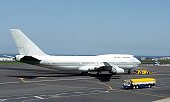Introduction
NetJets, a subsidiary of Berkshire Hathaway, is a leader in the private aviation sector, providing fractional ownership and rental companies for private jets. The corporate has established itself as a premium service supplier, catering to a clientele that values convenience, flexibility, and luxurious. This case research delves into the pricing strategies employed by NetJets, exploring how these strategies align with the company’s overall business mannequin and customer expectations.
Overview of NetJets
Founded in 1964, NetJets pioneered the idea of fractional jet possession, which allows individuals and corporations to purchase a share of an aircraft, thereby lowering the prices associated with full possession. The corporate operates a fleet of over seven-hundred aircraft, offering providers across the globe. NetJets’ business model is built on the premise of providing a cheap and handy various to traditional private jet ownership.
Pricing Construction
NetJets employs a multifaceted pricing construction that features several parts: acquisition prices, management fees, hourly flight charges, and additional service charges. Understanding these parts is crucial for analyzing the general pricing technique.
1. Acquisition Costs
Acquisition costs check with the preliminary investment required to buy a fractional share in a jet. The value of a share varies depending on the size and type of aircraft. For instance, a quarter share in a big cabin jet can value upwards of $1 million, while smaller jets can be acquired for significantly less. This initial investment is a major barrier to entry for a lot of potential customers, positioning NetJets as a premium service supplier.
2. Administration Charges
In addition to the acquisition costs, NetJets prices annual management charges. These fees cover the operational prices related to sustaining the aircraft, including pilot salaries, maintenance, and insurance coverage. Management charges usually vary from 10% to 15% of the preliminary investment per 12 months, depending on the scale of the share and the aircraft type. This ongoing cost ensures that clients have entry to a properly-maintained aircraft with out the problem of day-to-day management.
3. Hourly Flight Charges
Hourly flight rates are one other critical element of NetJets’ pricing strategy. These charges vary primarily based on the aircraft kind and the distance traveled. For instance, the hourly charge for a light jet can range from $2,000 to $4,000, while larger jets can command charges of $5,000 to $10,000 per hour. This tiered pricing construction allows NetJets to cater to a various clientele, from people seeking occasional journey to corporations requiring frequent flights.
4. Additional Service Fees
NetJets additionally fees further charges for providers beyond the standard flight expertise. These can embrace catering, floor transportation, and particular requests. By providing customizable options, NetJets enhances the client experience but additionally introduces variability in pricing. This flexibility is appealing to purchasers who need a tailored travel experience, however it could possibly complicate the general pricing structure.
Aggressive Evaluation
NetJets operates in a aggressive landscape that includes different fractional possession firms, charter services, and conventional jet possession. Key rivals include Flexjet, Wheels Up, and VistaJet. Each of those firms has its distinctive pricing strategies, however NetJets differentiates itself through its extensive fleet, popularity for reliability, and dedication to customer support.

1. Worth Proposition
NetJets positions itself as a premium service provider, emphasizing high quality over value. This technique is mirrored in its pricing, which tends to be larger than many competitors. Nevertheless, the company justifies this premium by highlighting its superior customer support, security report, and operational effectivity. For many purchasers, the value of peace of thoughts and comfort outweighs the upper price level.
2. Customer Segmentation
NetJets targets excessive-net-worth people and corporations that prioritize time and convenience. The pricing strategy is designed to enchantment to this demographic, offering a blend of luxury and practicality. By focusing on customer segmentation, NetJets can tailor its marketing efforts and pricing strategies to align with the particular wants and preferences of its audience.
Economic Factors Influencing Pricing
Several economic elements affect NetJets’ pricing methods. The demand for private jet charter prices jet travel tends to fluctuate primarily based on economic circumstances, gas prices, and global events. For instance, during financial downturns, demand for fractional possession could decrease as people and corporations reduce again on discretionary spending. Conversely, in times of economic progress, demand for private aviation usually increases, permitting NetJets to adjust its pricing accordingly.
Buyer Experience and Satisfaction
NetJets locations a powerful emphasis on customer expertise, which is integral to its pricing strategy. The company invests heavily in customer support, making certain that clients receive personalized attention and support. If you have any queries about wherever and how to use private jets charter flights, you can get in touch with us at the internet site. This dedication to buyer satisfaction helps justify the premium pricing, as clients are willing to pay more for a superior experience.
Conclusion
NetJets’ pricing technique is a complex interplay of acquisition costs, administration charges, hourly rates, and extra service fees. By positioning itself as a premium service provider, the company successfully caters to a high-internet-value clientele that values comfort and high quality. Despite the competitive panorama, NetJets maintains its market leadership by means of a commitment to customer support and operational excellence. Because the private jet rental aviation sector continues to evolve, NetJets will need to adapt its pricing methods to fulfill changing customer expectations and financial conditions while preserving its repute as a pacesetter within the business.



